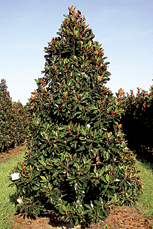The Southern Magnolia is an evergreen tree that grows naturally throughout much of the southeastern United States and can be found from eastern North Carolina, all the way west to easternmost Texas. The Southern Magnolia’s creamy, white fragrance-filled bloom was chosen in 1900 by students from Mississippi to be the state flower and voted to become the official state tree in 1938. The iconic bloom is also the unofficial representative of America’s Deep South.
The deep-green waxy leaves and beautiful blossoms, accompanied with the sheer size of the Southern Magnolia, give the tree numerous ornamental values for any landscaping. The species is a prime candidate for a specimen tree within a planted bed, grown alone or even as a backdrop for other trees. The Southern Magnolia also qualifies as a shade tree and a tree that highlights golf courses and parks, or you can plant them as buffers to absorb noise from your neighborhood or as screens to allow you some privacy.
The blossoms of the Southern Magnolia open up intermittently throughout the warmer months of the spring and summer and the scent is strong enough to “perfume the entire garden,” according to the University of Florida IFAS Extension. The flowers release a strong pleasant fragrance reminiscent of lemons; when the branches are injured or crushed, that portion of the tree releases a citrus like scent.
They are known partly for their large size as they typically grow to a height of up to 80 feet with a spread of up to 40 feet, but various cultivars give you choices. For an area too small to handle a big tree, the “Little Gem” typically reaches 12 feet to 20 feet and produces proportionally smaller flowers, but still allows you to enjoy the beauty and scent of the evergreen. The “Bracken’s Brown Beauty” is a popular-spreading hybrid with fuzzy brown leaves. If you’d like to make a big statement, the “Majestic Beauty” can fulfill that goal with the flowers it produces that can be as wide as one foot in diameter.
Magnolias are ancient plants that can live for more than 100 years and are believed to have existed on the planet for at least 95 million years. Since the trees appeared before bees, magnolias slowly changed their flowers to become more attractive to bees, ensuring successful pollination. They don’t produce nectar but instead yield a pollen that is enriched with proteins, which bees use as food, and the flowers release a sugary scent that attracts the pollinators.
This column is a joint effort by all at the local garden center, In The Garden, at 3889 Sanibel Captiva Road, Sanibel. For information, contact 239-395-5859 or visit www.facebook.com/rswalshinthegarden.
